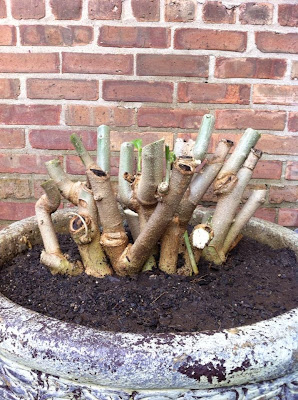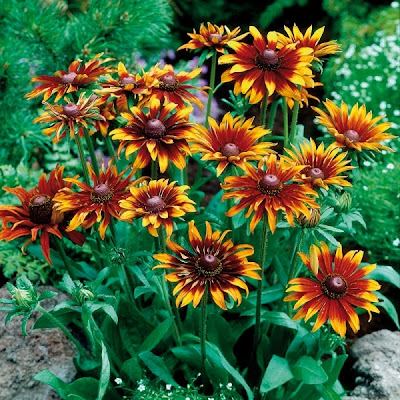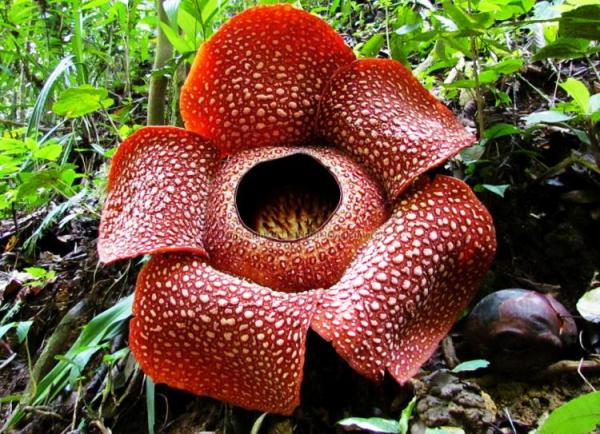If you are looking to create a tropical effect garden, or just want an impressive, flowering specimen plant to adorn your garden, you will be hard pushed to find a better example than a Brugmansia - otherwise known as the Angels trumpet.
 |
| Image credit - www.floridagardener.com |
The trumpet shaped flowers are often heavily scented, more-so in the evenings, and depending on the species or cultivar can come in shades of white, yellow, pink, orange, green, or red. Flowers may be single, double, but new cultivars can be even more.
Brugmansia species are a native to tropical regions of South America, along the Andes from Venezuela to northern Chile, and also in south-eastern Brazil. They are grown as ornamental container plants world-wide, and have become naturalized in isolated tropical areas around the globe, including within North America, Africa, Australia, and Asia.
 |
| Image credit - www.faroutflora.com |
They are best grown as shrubs pruned back hard annually, but they are also very effective when grown as small standards. Let them grow to the required height the pinch out the growing tips to encourage branching.
How to over-winter Brugmansias
In the cold winter climates of northern Europe and North America the subtropical Brugmansia is highly unlikely to survive without the help of a bit more global warming, and so for now your only option is to give it a helping hand.
 You can begin preparing Brugmansias for overwintering from the end of September by slowly reducing the amount of water they receive. If they are growing in the ground then carefully lift the plant and pot it on into a suitably sized container. Give it a good watering initially, but the plant will still need its watering sufficiently reduced afterwards to help bring it into a state of dormancy. It is also a good idea to reduce the plants canopy by 1/3rd to help reduce water loss from its core through transpiration.
You can begin preparing Brugmansias for overwintering from the end of September by slowly reducing the amount of water they receive. If they are growing in the ground then carefully lift the plant and pot it on into a suitably sized container. Give it a good watering initially, but the plant will still need its watering sufficiently reduced afterwards to help bring it into a state of dormancy. It is also a good idea to reduce the plants canopy by 1/3rd to help reduce water loss from its core through transpiration.Keep an eye on overnight temperatures because Brugmansias can be severely damaged by frost. You will need to have brought them in under protection before frosts occur otherwise you will risk losing the entire plant. However, because Brugmansias can reach a fairly unwieldy size over the course of the year, it is likely that they will need a fairly severe pruning before bringing it inside. You can be quite brutal here as Brugmansias will readily grow back in the spring. Remember that the more you can trim it back - the easier it will be to deal with.
A word of caution with regards to Brugmansia –and it’s not about their well-known toxic nature – is their attractiveness to insect pests. Before bringing inside it is best to check the plant over and remove any pests that may themselves be hoping to overwinter in the leaves, stems and even the root system. Spray with an organic insecticide or remove all the leaves before placing the plant into a cool, dry, frost-free position - such as a basement - where it can be allowed to go dormant. It is important that temperatures do not drop below about 5 degrees Celsius during this period.
Check every few weeks to make sure the soil doesn't dry out too much and only water as necessary to keep the soil slightly moist.
In the spring, once the danger of frosts are over, move over-wintered Brugmansias back outside or plant in the ground for the following season.
For related articles click onto:
Agave
Allium giganteum
Aloe vera
Bamboo
Buy Agave Seed
Buy Aloe vera Seed
Bird of Paradise Flower
Christmas Cactus Care
Coleus
Dinosaur Plants: The Cycad
Dinosaur Plants: The Sago Palm
Dracunculus vulgaris - The Dragon Lily
Echiums
Choosing Hardy Cacti and Succulents for Growing Outside
Growing Geraniums from Seed
How to Grow Bamboo
How to Grow the Calla Lily
How to Grow Colocasia
How to Grow Dahlias from Seed?
How to Grow Echium from Seed
How to Grow Lobelia from Seed?
Hardy Exotic Plants for that Tropical Garden Effect
How to Grow Palm Trees from Seed
How to Grow Aloe vera from Seed
How to Grow Banana Trees from Seed
How to Grow Brugmansia
How to Grow Geraniums from Seeds
How to Grow the Glory Lily (Gloriosa superba) from Seed
How to Grow Remusatia
How to Grow Roses from Seed
How to Grow the Sago Palm from Seed
How to Propagate Bamboo?
Lotus berthelotii
Paeony lactiflora 'Bowl of Beauty'
Schlumbergera Species - The Christmas Cacti
The Calla Lily
The Eyeball Plant
The Monkey Puzzle Tree - Araucaria araucana
Trachelospermum jasminoides
What has the Christmas cactus got to do with Christmas?
Hardy Cacti and Succulents for Growing Outside
What is an Agave?
What is Aloe vera?
What is Bamboo?
What is a Jade Plant?































































